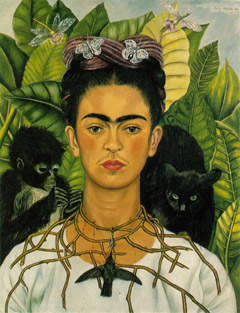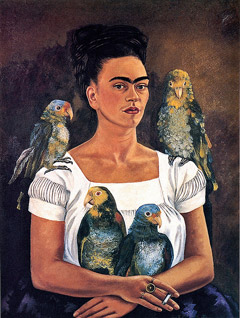Frida Kahlo

Early Years
Frida Kahlo grew up in her family home which was referred to as Casa Azul. Her German father Wilhelm was a photographer who immigrated to Mexico and married Matilde, Kahlo’s mother. There were two older sisters Adriana and Matilde and a younger sister Cristina. Aged just 6 years, Frida contracted the disease polio and was bedridden for 9 months. She recovered but retained a limp. Her father encouraged physical activity, some quite unusual for a girl including wrestling, football and swimming.
Education
Frida Kahlo went to the National Preparatory School as one of only a few female students. She is remembered for her jolly spirit, bright coloured clothes jewellery and her love of all things traditional. She belonged to a group of like-minded friends who were both intellectual and politically aware. In 1925 she was severely injured in a bus accident and was impaled by a steel hand rail. Her injuries were serious and included fractures of the spine and pelvis.

Married Life
Frida Kahlo began a relationship with Diego Rivera who she had first met when he visited her school, they married soon after. He encouraged her work and the two would move around to wherever Rivera received commissions for his artwork. In 1930 Kahlo showed her work in San Francisco. She began to incorporate more surreal and graphic elements into her pictures. The work was, in ways, deeply personal referring to her second miscarriage. After this spell in America, the couple returned to Mexico.
The marriage was not a traditional one and both parties retained separate homes and studios next to each other. Despite it being an unconventional marriage Kahlo was hurt by Rivera’s many infidelities which included an affair with Cristina her younger sister. In response Kahlo cut her hair and once more experienced the devastation of yet another miscarriage.
Art

Moving to Paris in 1939, Kahlo exhibited paintings and became friends with Pablo Picasso and Marcel Duchamp. This was the year when she divorced her husband and painted arguably her most famous work “The Two Fridas” representing the loved and unloved Fridas. The divorce from Rivera was short lived and they remarried in 1940 but continued to lead quite separate lives and develop involvements with other people.
The death of her father was a blow along with her continuing chronic health problems and by the early 1940s she had undergone several surgeries and wore surgical corsets in an attempt to relieve her back pain. She was always seeking a variety of treatments for her chronic pain without success. Despite her pain, she continued to work becoming forever more popular and her health issues began to feature in her work.

Kahlo sunk into depression and continued to suffer with bad health and intermittent hospitalisation while her strong spirit continued with her political activism. At the young age of 47 Kahlo finally succumbed to death and it remains subject to speculation whether it was medical causes or suicide.
Legacy
Frida Kahlo’s Casa Azul opened in 1958 as a museum. The 1970s feminist movement led to a renewal of interest in her art and life. A film was made of her life entitled Frida in 2002 starring Salma Hayek as the artist.
“I used to think I was the strangest person in the world but then I thought there are so many people in the world, there must be someone just like me who feels bizarre and flawed in the same ways I do. I would imagine her, and imagine that she must be out there thinking of me too. Well, I hope that if you are out there and read this and know that, yes, it’s true I’m here, and I’m just as strange as you.”
– Frida Kahlo

Frida Kahlo, ooh yes. I love her bizarre quirkiness her imagination, and the surreal elements in her work. A great inspiration for poetry! There is a wonderful collection of poems inspired by Kahlo’s work, Pascale Petit’s What the Water Gave Me, showing how well art and poetry works together. Thanks, Su, for this. Jennie x
Thanks Jennie. And for letting us know about “What the Water Gave Me” by Pascale Petit. I shall have to find a copy for the deepspacelibrary!
Look out for the next post with photo’s taken only yesterday of Las Casa Azur by Janie Ranger, deepspacestudio artist reporting from Mexico City!